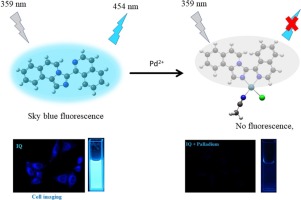Journal of Photochemistry and Photobiology A: Chemistry ( IF 4.1 ) Pub Date : 2020-02-19 , DOI: 10.1016/j.jphotochem.2020.112441 Satyajit Mahata , Araghni Bhattacharya , Jadi Praveen Kumar , Biman B. Mandal , Vadivelu Manivannan

|
The heterocyclic probe 3-(1-isoquinolinyl)imidazo[5, 1-a]isoquinoline (IQ) in CH3OH/HEPES buffer system (5 mM, pH = 7.4, 6:4, v/v), exhibits blue fluorescence (λem = 454 nm) upon excitation with 359 nm light. Upon adding Pd2+ ion solution, IQ shows “turn-off” response when observed under long UV light. Using IQ bivalent palladium can be detected with a low limit of detection (0.210 μM) within the pH range of 2-8. In the presence of large varieties of metal ion, colorimetric and fluorescence responses did not exhibit any perceptible change. A small change in fluorescence life-time in TRPL study indicates the static nature of quenching. Binding of probe IQ with Pd2+ ion can be reversed using Na2EDTA. Job’s plot and ESI mass spectrometric analysis reveal a 1:1 ratio for binding of IQ with Pd(II) ion. DFT/TDDFT calculations performed on [Pd(IQ)Cl(CH3CN)]+ ion support the experimental findings. Cytotoxic studies showed that probe IQ suppressed the growth of L929 and Hela cells in a dose-dependent manner. Fluorescence imaging in the absence and presence of Pd2+ revealed that IQ can be successfully applied on living cells with outstanding sensitivity.
中文翻译:

肉眼检测的Pd 2+使用高度选择性荧光探针杂环通过离子“转-关”响应,并在-体外活细胞成像
CH 3 OH / HEPES缓冲液系统(5 mM,pH = 7.4,6:4,v / v)中的杂环探针3-(1-异喹啉基)咪唑啉[5,1- a ]异喹啉(IQ)显示蓝色荧光(λ EM在用359纳米的光激发= 454纳米)。加入Pd 2+离子溶液后,当在长紫外线下观察时,IQ会显示“关闭”响应。使用智商可以在2-8的pH范围内以低检测限(0.210μM)检测二价钯。在存在大量金属离子的情况下,比色和荧光响应未显示任何可察觉的变化。TRPL研究中荧光寿命的微小变化表明淬灭的静态性质。可以使用Na 2 EDTA逆转探针IQ与Pd 2+离子的结合。Job的图和ESI质谱分析显示IQ与Pd(II)离子的结合比例为1:1 。对[Pd(IQ)Cl(CH 3 CN)] +离子进行的DFT / TDDFT计算支持了实验结果。细胞毒性研究表明探针IQ剂量依赖性地抑制L929和Hela细胞的生长。在不存在和存在Pd 2+的情况下进行的荧光成像显示,IQ可以成功地以优异的灵敏度应用于活细胞。











































 京公网安备 11010802027423号
京公网安备 11010802027423号